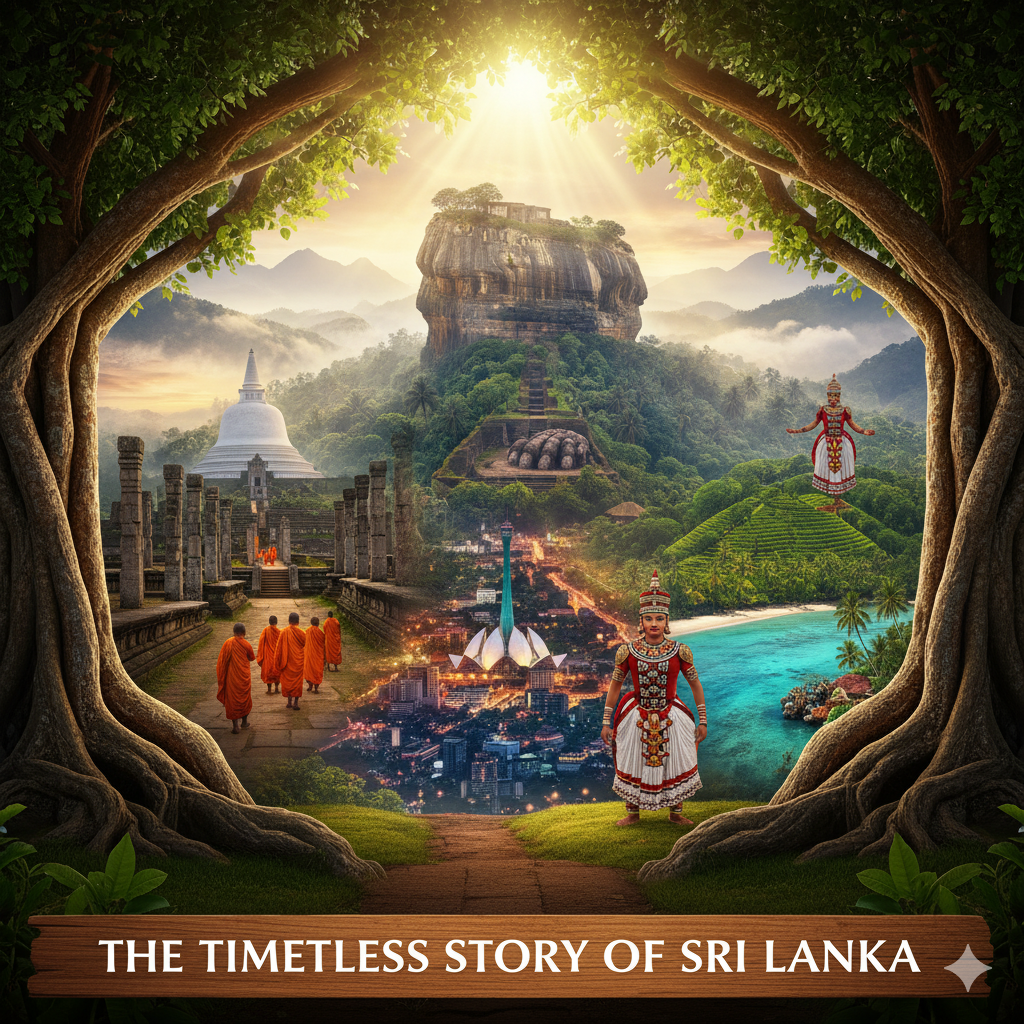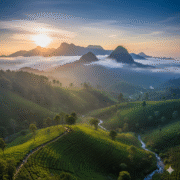
The Timeless Story of Sri Lanka
- November 13, 2025
- eunoialankatours
- 7:26 pm
📜 A Traveler’s Guide to 12,000+ Years of Living Heritage
Welcome: Where History Still Breathes
Sri Lanka isn’t just a place you visit; it’s a story you walk through—stone by stone, shrine by shrine, smile by smile. From rainforest caves with the earliest Homo sapiens in South Asia to royal capitals, rock fortresses, the last Sinhalese kingdom, and colonial-era seafaring towns, the island’s past is surprisingly close to the surface. Travel with Eunoia Lanka Tours and you won’t just see history—you’ll feel it, like a local.
1) Dawn of Humanity: Cave Light and Rainforest Skill
Far before cities and kings, people thrived here. In the wet-zone cave of Fa-Hien Lena , archaeologists found 48,000-year-old bone arrowheads—the earliest bows-and-arrows outside Africa—plus beads and pigments, evidence of skilled rainforest foragers with a flair for adornment. Nearby sites such as Batadombalena add to this deep record of early modern humans on the island.
2) Anuradhapura: Faith, Reservoirs, and a Hydraulic Civilization (377 BCE–1017 CE)
When Buddhism arrived (3rd century BCE), Anuradhapura blossomed into a sacred city—home to stupas, monasteries, and the venerated Sri Maha Bodhi (a sapling from the Buddha’s enlightenment tree). Kings engineered vast tanks and canals that turned dry plains into rice country, birthing a world-class irrigation culture that still shapes the landscape. Walk the terraces of Ruwanwelisaya or gaze across ancient lakes, and you’re seeing a civilization designed around water, worship, and wisdom.
3) Sigiriya: Sky Palace, Poetry, and Power (5th century)
Sigiriya is a 200-meter-high granite monolith that rises from the jungle. It was King Kassapa’s daring rock-top palace with moats, fountains, and smooth walls.
- The magnificent frescoes are still bright halfway up.
- Between the 7th and 13th centuries, pilgrims carved poetry into the Mirror Wall. These were love letters to beauty and the nature that read like early travel reports.
- The sunrise at the top tells two things at once: royal ambition and excellent art.
4) Polonnaruwa: Sculpture in Full Voice (11th–13th centuries)
Polonnaruwa became the island’s new heart after Anuradhapura. Gal Vihara is the main attraction. It has four Buddha statues carved from a single piece of granite: one sitting, one standing, and one reclining in a peaceful state of Parinirvana. These are works of art in terms of proportion, line, and spiritual quiet. The lotus ponds, royal grounds, and picture houses are all great places to walk about. It feels like the city is holding its breath.
5) The Kingdom of Kotte & Cultural Renaissance
By the 15th century, the Kingdom of Kotte brought a cultural rebirth under King Parakramabahu VI. Literature thrived—this was the golden age of Sinhalese poetry. Yet, the 16th century also brought change: the arrival of the Portuguese marked the beginning of European colonial entanglements.
👑 Kandy: The Last Kingdom and Colonial Legacies
6) Kandy: The Last Sinhalese Kingdom and a Living Sacred City (c. 1469–1815)
Kandy was the last capital of the Sinhala monarchs and held out the longest against European empires. It was surrounded by hills and a lake. Today, it is a UNESCO World Heritage Site because of the Temple of the Sacred Tooth Relic (Sri Dalada Maligawa) . This is a place where people go on pilgrimage and devotion shapes their everyday lives. For hundreds of years, owning the Relic meant having the right to rule. This is how closely church and state were linked here.
Plan your trip around the Esala Perahera, one of Asia’s biggest annual parades, when elephants dressed up in fancy clothes, dancers, drummers, and torchlight walk through the city.
What makes Kandy unforgettable for travelers?
- The lakeside walk at dusk, drums rising from the shrine.
- The palace-temple ensemble where kings once convened.
- Art and dance traditions that still pulse through festivals.
Kandy is where “heritage” is not a museum word—it’s a rhythm you can hear.
7) The Turning Point: The Kandyan Convention (1815)
The Kandyan Convention was signed by local leaders in 1815. It removed Sri Vikrama Rajasinha from power and gave the kingdom to Britain. It brought the whole island under one colonial government and put an end to the line of independent Sinhalese kings. The incident changed the course of Sri Lanka’s politics, and it serves as a distinct historical marker for any trip to Kandy’s royal area.
8) Colonial Era Layers: Portuguese, Dutch, British (1505–1948)
Sri Lanka’s strategic location made it a coveted prize:
- Portuguese (1505–1658): They fortified coastal areas, introducing Christianity while clashing with local kingdoms.
- Dutch (1658–1796): Expanded forts, canals, and laws—many of which influenced Sri Lanka’s administrative systems.
- British (1796–1948): Unified the island under one administration, developed tea plantations in the highlands, and built railways that still run today.
Ports, forts, canals, missions, railways, tea: European powers left heavy footprints. The Portuguese and Dutch shaped coastal trade and defenses; the British bound the highlands with track and introduced large-scale tea cultivation, turning misty hills into emerald mosaics. You feel these layers in Galle Fort streets , in hill-country bungalows, and on the rails from Colombo to Ella.
9) Independence and Now (1948–Today)
In 1948, Sri Lanka became free again. Since then, the island has seen both good and bad times. Today, it invites visitors to a stunningly unique mix of languages, foods, animals, beaches, and rituals. The tale goes on, and visitors are a part of it.
🌟 Why This History Matters to Travelers
For visitors with Eunoia Lanka Tours, history is not just dates and dynasties—it’s an immersive experience. Imagine:
- Meditating under the shade of the Sri Maha Bodhi, a tree linked directly to the Buddha.
- Climbing Sigiriya at sunrise to watch the plains awaken.
- Walking barefoot through Gal Vihara, where ancient artisans captured eternal serenity in stone.
- Exploring colonial Galle Fort, where cobblestone streets echo with stories of sailors and spice traders.
How to feel this history with Eunoia Lanka Tours:
- Anuradhapura & Mihintale: Circle stupas at dawn, then meet a village farmer who still relies on ancient tank water.
- Sigiriya: Climb early, read a Mirror Wall verse on the way down, then explore the symmetrically planned water gardens.
- Polonnaruwa: Pause at Gal Vihara and let the quiet do the talking.
- Kandy: Attend a morning or evening pooja at the Temple of the Tooth; if you come in July/August, we’ll help you experience the Esala Perahera respectfully and up close.
Our Promise
At Eunoia Lanka Tours we champion the Wonder of Diversification—Feel Like a Local. We pair scholarship with storytelling, logistics with empathy, and monuments with the people who keep them alive. Ready to turn moments into memories?
This content is perfectly ready for your blog. Would you like me to draft a quick, 3-day itinerary focusing on Anuradhapura, Sigiriya, and Polonnaruwa to complement this history piece?


